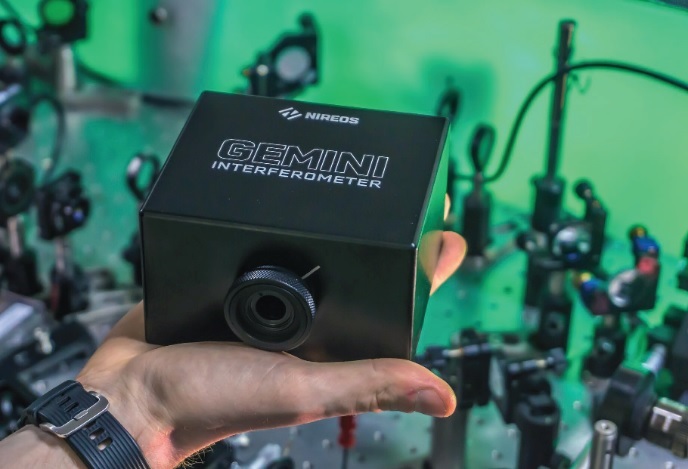April 08, 2019
NIREOS, a fast-growing Spin-off company of the Physics Department of Politecnico di Milano University introduces the innovative ultra-stable interferometer - GEMINI, the ideal device for broadband steady-state and time-resolved spectroscopy.
NIREOS introduces GEMINI, a novel and patented interferometer (see figure on the right). It is an ideal device that can be easily added to any existing setup to measure the spectrum of a light source, either coherent (such as a broadband laser) or incoherent (as a light bulb, an LED or even fluorescence from a sample). Better than a spectrometer, as GEMINI only requires a single-pixel detector. Better than a monochromator, as GEMINI overcomes many of its typical drawbacks, having:
o Very high throughput because GEMINI provides 10-mm clear aperture (free space propagation with a collimated beam through the device, lacking entrance or exit slits);
o User adjustable spectral resolution without affecting light throughput;
o An ultra-broadband spectral coverage (250 nm to 3500 nm);
o Easy to align, plug-and-play operation;
o A compact footprint (10 x 11 x 6 cm) and lightweight;
o Equipped with control software and Labview examples for easy integration into existing setup systems.

NIREOS has demonstrated that GEMINI can be successfully applied to many different experiments, both in steady-state and time-resolved spectroscopy. For example, the combination of its high throughput and exceptional stability makes it the perfect tool for enabling the measurement of fluorescence excitation-emission maps, down to the single molecules limit. The GEMINI Interferometer can be also easily coupled to time-resolved detection systems – such as photomultiplier tubes (PMTs) or single-photon avalanche diodes (SPADs) connected with a time correlated single photon counting system (TCSPC) – to measure time- and frequency-resolved fluorescence maps, as a function of decay time and wavelength (see figure on the right for an experimental result).
This novel device expresses all its potential in non-linear spectroscopy as well. In particular, it has been applied to:
o Pump-probe spectroscopy: thanks to the employed time-domain Fourier Transform detection system, the GEMINI allows one to measure the broadband pump-probe signal with a single-pixel detector and a single-channel lock-in amplifier. In this way, it is possible to combine an ultra-broad spectral coverage with an extremely high sensitivity, due to high frequency modulation (in the MHz regime) and detection (for more information, please refer to this NIREOS’ Application Note: https://bit.ly/2HFXLB2).
o Two-dimensional (2D) spectroscopy: the advanced version of the GEMINI
Interferometer, called GEMINI-2D, has been specially designed to transform a standard pump-probe (or transient absorption) experiment into a 2D spectroscopy system. The GEMINI-2D must be inserted in the pump beam of a pump-probe setup to generate a pair of collinear, delayed and phase-locked pump pulses, which are required for this experiment.
HOW DOES IT WORK?
There are two main methods to measure a light spectrum: the frequency-domain and the time-domain approach. In the frequency-domain technique, a prism or grating disperses the light frequency components, which are individually measured by the elements of a multichannel detector. In the time-domain approach, the light is split by an interferometer in two delayed and collinear replicas, whose interference pattern is measured by a single-pixel detector as a function of their relative delay. This produces an interferogram, whose Fourier-Transform (FT) yields the intensity spectrum of light.
With respect to dispersive spectrometers, the FT method has prominent advantages, such as a higher signal-to-noise ratio (the Fellgett’s multiplex advantage), a higher throughput (due to the absence of entrance and exit slits) and a variable spectral resolution.
The splitting is typically performed by a beam splitter in an amplitude division interferometer, such as the Michelson interferometer or similar. However, the technical challenges of such systems are mainly related to the requirement to control the delay of the replicas within a small fraction (1/100 or better) of the optical cycle, and to keep the two replicas collinear. This has restricted the use of the time-domain approach in the IR region only up to now.
The GEMINI Interferometer completely overcomes the limitations of standard interferometers, thus enabling for the first time the use of the time-domain approach in the visible and UV spectral regions. Its working principle, based on an innovative polarization division interferometer with common-path geometry, inherently guarantees an unrivalled stability and accuracy. In particular, the GEMINI has the following unique properties:
o the relative delay between the two generated replicas is locked with very high stability and reproducibility;
o it allows extremely high delay accuracy (better than 1 attosecond, i.e. better than 1/1000 of the optical cycle in the visible range);
o it is inherently phase stable and does not require any feedback stabilization;
o the two replicas remain aligned even in the presence of considerable mechanical perturbations of the device.
These are some of the possible applications that can benefit from the unique features of the GEMINI Interferometer.
For more information, visit NIREOS website: www.nireos.com.















